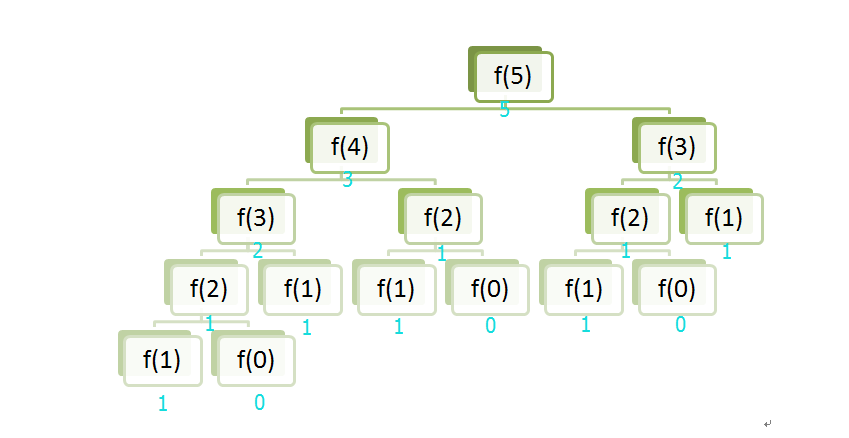今天学长教了递归,下面说说我对递归的一些理解。
以下面这个题目为例:
题目描述
Ø例5.2 求Fibonacci数列问题。
─斐波那契数列指的是这样一个数列:
─0、1、1、2、3、5、8、13、21、……
─F[0]=0, F[1]=1, F[i]=F[i-1]+F[i-2], i>=2;
编程输出前n个Fibonacci数
输入
输入n
输出
输出前n个Fibonacci数
样例输入
5
样例输出
0 1 1 2 3
当求F[5]时,它们的层数关系如下:

求F[5]时就要知道F[4]和F[3]的值,而F[4]的值等于F[3]+F[2],F[3]的值等于F[2]+F[1],依次递归下去,由于F[1]和F[0]的值知道,所以直到等于F[1]或F[0]时递归结束。
具体代码如下:
1 #include <iostream> 2 using namespace std; 3 4 int f(int x){ 5 if(x == 0){ 6 return 0; 7 } 8 else if(x == 1){ 9 return 1; 10 } 11 else return f(x-1)+f(x-2); 12 } 13 int main(){ 14 int n; 15 cin >> n; 16 for(int i = 0; i < n; i++){ 17 cout << f(i) << endl; 18 } 19 return 0; 20 }
类似的递归问题还有:
题目描述
对1~ n 的 n个整数进行全排列(n<=9),编写程序输出所有可能的排列组合. 用递归算法实现.
输入
输入n
输出
输入n个整数的所有可能的排列组合.
样例输入
3
样例输出
1 2 3 1 3 2 2 1 3 2 3 1 3 2 1 3 1 2
1 #include <iostream> 2 #include <cstdio> 3 #include <algorithm> 4 using namespace std; 5 void f(int arr[], int k, int m){ 6 if(k == m){ 7 for(int i = 0; i <= m; i++){ 8 printf("%4d",arr[i]); 9 } 10 printf(" "); 11 } 12 else{ 13 for(int i = k; i <= m; i++){ 14 swap(arr[i], arr[k]); 15 f(arr, k+1, m); 16 swap(arr[i], arr[k]); 17 } 18 } 19 } 20 int main(){ 21 int n; 22 cin >> n; 23 int a[11]; 24 for(int i = 0; i < n; i++) 25 a[i] = i+1; 26 f(a,0,n-1); 27 return 0; 28 }
题目描述
汉诺(Hanoi)塔问题:古代有一个梵塔,塔内有三个座A、B、C,A座上有n个盘子,盘子大小不等,大的在下,小的在上(如图)。有一个和尚想把这n个盘子从A座移到C座,但每次只能允许移动一个盘子,并且在移动过程中,3个座上的盘子始终保持大盘在下,小盘在上。在移动过程中可以利用B座,要求打印移动的步骤。如果只有一个盘子,则不需要利用B座,直接将盘子从A移动到C。
输入
输入盘子个数n
输出
输出盘子最少移动的步骤
样例输入
3
样例输出
1:A->C 2:A->B 3:C->B 4:A->C 5:B->A 6:B->C 7:A->C
1 #include <iostream> 2 #include <cstdio> 3 using namespace std; 4 void move(char x, char y); 5 void f(int n, char a, char b, char c){ 6 if(n == 1) 7 move(a, c); 8 else{ 9 f(n-1,a,c,b); 10 move(a,c); 11 f(n-1,b,a,c); 12 } 13 } 14 void move(char x, char y){ 15 static int i = 1; 16 printf("%d:%c->%c ",i++,x,y); 17 } 18 int main(){ 19 int n; 20 cin >> n; 21 f(n, 'A', 'B','C'); 22 return 0; 23 }
题目描述
八皇后问题
是一个古老而著名的问题,是回溯算法的典型案例。
该问题是国际西洋棋棋手马克斯·贝瑟尔于1848年提出的,在8*8格的国际象棋上摆放八个皇后;使其不能互相攻击,即任意两个皇后都不能处于同一行、同一列或同一斜线上;
问有多少种摆法, 输出所有可能的解?
1 #include <iostream> 2 #include <cstdio> 3 #include <cmath> 4 using namespace std; 5 const int N = 8; 6 int a[N][N] = {0}; 7 void Print(){ 8 static int ans = 1; 9 printf("Case %d: ",ans++); 10 for(int i = 0; i < N; i++){ 11 for(int j = 0; j < N; j++){ 12 printf("%c ",a[i][j]?'Q':'.'); 13 } 14 printf(" "); 15 } 16 printf(" "); 17 } 18 bool Safety(int row, int col){ 19 for(int i = 0; i < row; i++){ 20 for(int j = 0; j < N; j++){ 21 if(a[i][j]&&(j==col||abs(row-i)==abs(col-j))) 22 return false; 23 } 24 } 25 return true; 26 } 27 void BlackTrack(int i){ 28 if(i >= N){ 29 Print(); 30 return; 31 } 32 else{ 33 for(int j = 0; j < N; j++){ 34 a[i][j] = 1; 35 if(Safety(i,j)){ 36 BlackTrack(i+1); 37 } 38 a[i][j] = 0; 39 } 40 } 41 } 42 int main(){ 43 BlackTrack(0); 44 return 0; 45 }
输入
没有输入
输出
输出所有可能的解